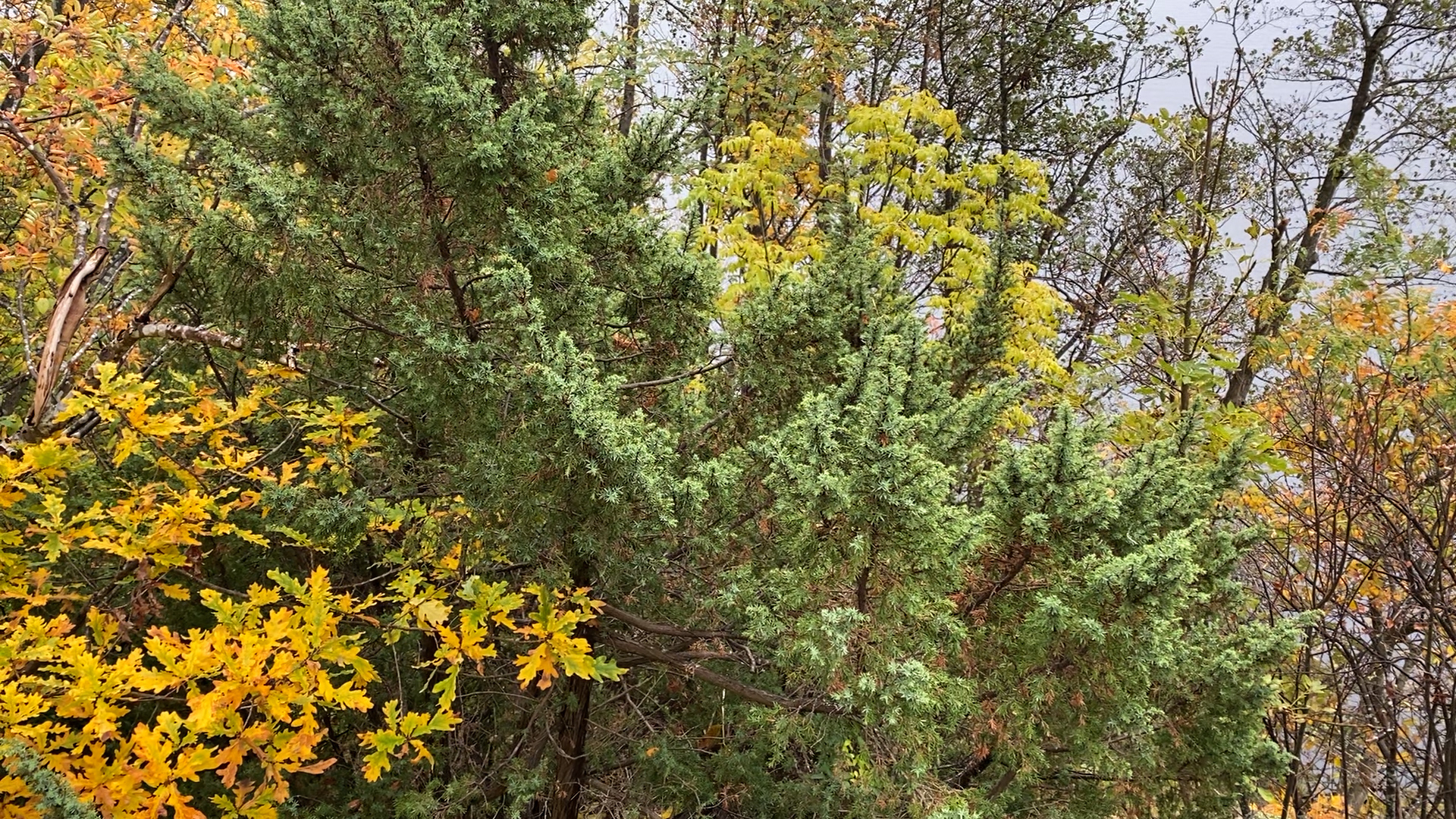Hello juniper, we haven't met before, but I've walked past here so I remembered you. I've been visiting another juniper further towards the city centre, repeatedly actually but with her I speak Swedish so now, when I wanted to have a conversation in English, I decided to come to you. Now because I can't come really close to you, you're growing on a cliff and there is rail that I should cross, I might do that some other time, but right now I cannot see if you have batteries or not. Because your form suggests that you might be a female juniper, but I don't see any berries from this distance, because unlike many other trees and shrubs junipers are either male or female. But anyway, I apologise now if I use the wrong pronoun for you. My idea was to speak a little bit or think together with you a little bit about performance. And that's a word that is really difficult to translate to many languages including Finnish and Swedish, or the words that normally are used for performance refer more to shows or representation or - they don't include this notion of action or accomplishment or doing as performance does in English, especially in American English but I think to some extent in British English as well. I remember an old book, I don't remember the author actually, called To act, to do, to perform, or was it maybe To do, to act, to perform, I don't remember, about theatre. But then there is of course the classic distinction made by Richard Schechner in his guidebook or handbook for students where he speaks of doing and showing doing and according to him performance is somehow the showing doing. But I like the idea of performance being also the doing, the accomplishment, the power of execution like you can speak of the performance of an engine or sports performance, I mean there is a shop called Peak Performance selling sports clothes and so on. So, not only this dimension of spectacle or representation or show. Now, of course now when I record your image on video as well as my voice in real time, this is a performance in both senses of the word so I'm performing an action of speaking and recording but I'm also speaking and addressing you in order for other people to hear this and watch this later. So why did I want to speak about performance with you? Because there is a call for papers and presentations for a conference which focuses on the question what performances are doing and especially what our performances are doing. So, not performances in general, but what would this kind of performance be doing or accomplishing. What would be the effect or impact or what does this doing do? So my doing is this talking to you and recording you, so what does this action do in the world? And of course then we could say do to whom or do to what? So does it have any effect on you that I talk to you? Or does it have any effect on me that I talk to you? Or does it have an effect on our relationship? Or perhaps even an effect on this place these cliffs here on Kungsholmen in Stockholm? Well, I would be tempted to say not much of an effect, but of course there is some effect. We are exchanging oxygen and carbon dioxide and maybe some other molecules through our breathing and exchanging them with the with the oak next to you and the rowan next to the oak and the ash tree further down and all the small animals and plants on the ground and in the ground and so on. I remember an old text written by Barbara Bolt, a pioneer of artistic research from Australia, from 2008 where she discusses the idea by Brad Haseman, the idea of a performative research paradigm and compares his ideas with the ideas of the of German theatre historian and scholar Erica Fischer-Lichte and her idea of sort of art becoming more and more performative that is accomplished together with the audience in recent years. And also with Judith Butler's and Karen Barad’s ideas of performativity in contrast to performance. But why I remember her is because she suggested that artistic researchers should look at what their work is doing. So, instead of describing their work or analysing it mapping the effects of that work in the world. Because the idea of a performative in the Austinian, J.L. Austinian sense is that it does something in the world. It is not true or false, but the performative is successful or unsuccessful or his word is felicitous, I can't even pronounce it, but happy or unhappy. And I remember that Barbara Bolt suggested that these effects in the world of an artwork or performance could be either material or discursive or affective. So, if I translate that to effects on me, which are easier to analyse than effects on you, that would mean that the material effects would for instance, could be like this coming out in the drizzle and talking to you would sort of be very good for my health or then this act of holding the camera in my hands would sort of create a strain on my elbow or. There are like embodied material effects of this action on me. There might be on you as well if I for instance would come closer and would carry some germs from a nearby plant or whatever. Or tramp, or if I would break a branch of yours by mistake and so on. So, material effects yes. And the discursive effects, that's of course most obvious now when I speak to you, this is a discourse of sorts and according to traditional discourse analysis it is not common to speak to shrubs. So, what I would see – and of course there could be other discursive effects like if I write an article about our encounter or transcribe these words and edit them into publication, quote them in a publication or something. But I like to translate this idea of discursive effects to somehow the conceptual effect, the idea of talking to a juniper as a conceptual gesture. And then there is of course the affective effects. And there I must confess that I don't know if you can sense human affect. I know my cats are very sensitive to my affective states, but whether a plant or a shrub would be that I don't know. And of course, I could say that your presence has an affective impact on me because I find you beautiful and refreshing and I regret that I don't have the right clothes to wear so I could climb under the fence and come closer to you. Well, I realised now when I look at the camera that I've been talking to you too long already, more than ten minutes so I'll stop by this. But I just want to end by saying thank you for letting me address you. And I wish you a nice Thursday afternoon in this soft misty drizzle in the end of October waiting for the coming winter. So, thank you and take care. Bye.
References:
John Langshaw Austin How to Do Things with Words Harvard University Press 1955/1962
Karen Barad Posthumanist Performativity: Toward an Understanding of How Matter Comes to Matter, Signs vol 28, no 3 2003
Barbara Bolt A Performative Paradigm for the Creative Arts? Working Papers in Art and Design 5, 2008
Judith Butler Bodies that Matter: On the Discursive Limits of Sex Routledge 1993
Erika Fischer-Lichte The Transformative Power of Performance Routledge 2008
Brad Haseman A Manifesto for Performative Research, Media International Australia Issue 118, 2006
IFTR 2026 World Congress 6th – 10th July 2026 What Theatre Does University of Melbourne, Australia
Alice Rayner To Act, To Do, To Perform: Drama and the Phenomenology of Action University of Michigan Press 1994
Richard Schechner Performance Studies: An Introduction Routledge 2002


